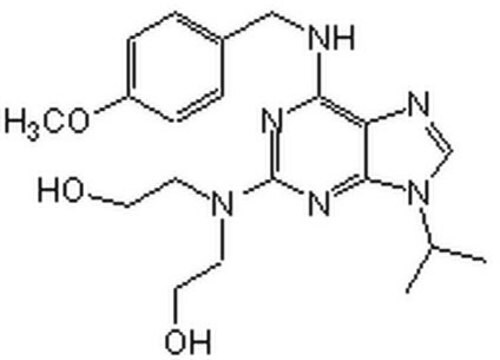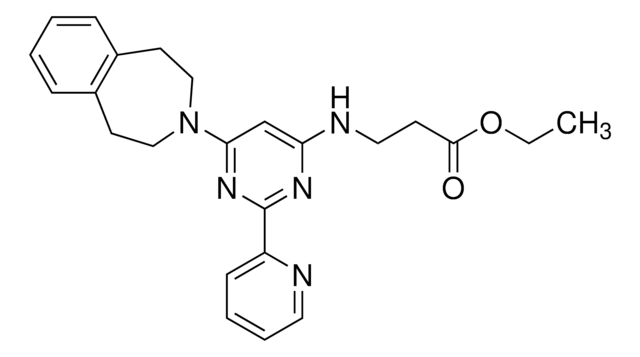SML1567
MCB-613
≥98% (HPLC)
Synonym(s):
4-Ethyl-2,6-bis(pyridin-3-ylmethylene)cyclohexanone
Sign Into View Organizational & Contract Pricing
All Photos(1)
About This Item
Empirical Formula (Hill Notation):
C20H20N2O
CAS Number:
Molecular Weight:
304.39
UNSPSC Code:
12352200
NACRES:
NA.77
Recommended Products
Quality Level
Assay
≥98% (HPLC)
form
powder
color
white to beige
solubility
DMSO: 5 mg/mL, clear (warmed)
storage temp.
2-8°C
General description
MCB-613 (4-Ethyl-2,6-bis-pyridin-3-ylmethylene-cyclohexanone) belongs to the chalcone class of compounds. It is an anti-neoplastic compound.
Application
MCB-613 has been used to study the molecular mechanism of MCB-613-induced cell death.
Biochem/physiol Actions
MCB-613 is a pan-Steroid Receptor Coactivator (SRC) stimulator. There are three steroid receptor coactivators (SRC) that interact with transcription factors and whose overexpression is assciated with a number of cancers, particularly breast cancer. MCB-613 overstimulates SRC activity in cancer cells resulting in excessive generation of reactive oxygen species (ROS), leading to cell stress and death by a process called paraptosis. MCB-613 is a cytotoxic molecule which can kill various human cancer cell lines, like HepG2 (liver), PC-3 (prostate) and MCF-7 (breast) cells.
MCB-613 is capable of inducing the transcriptional activity of steroid receptor coactivators (SRCs).
Storage Class Code
11 - Combustible Solids
WGK
WGK 3
Flash Point(F)
Not applicable
Flash Point(C)
Not applicable
Certificates of Analysis (COA)
Search for Certificates of Analysis (COA) by entering the products Lot/Batch Number. Lot and Batch Numbers can be found on a product’s label following the words ‘Lot’ or ‘Batch’.
Already Own This Product?
Find documentation for the products that you have recently purchased in the Document Library.
Lei Wang et al.
Cancer cell, 28(2), 240-252 (2015-08-13)
By integrating growth pathways on which cancer cells rely, steroid receptor coactivators (SRC-1, SRC-2, and SRC-3) represent emerging targets in cancer therapeutics. High-throughput screening for SRC small molecule inhibitors (SMIs) uncovered MCB-613 as a potent SRC small molecule "stimulator" (SMS).
Hyperactivation of nuclear receptor coactivators induces PERK-dependent cell death
Hossain MM, et al.
Testing, 9(14), 11707-11707 (2018)
Our team of scientists has experience in all areas of research including Life Science, Material Science, Chemical Synthesis, Chromatography, Analytical and many others.
Contact Technical Service







